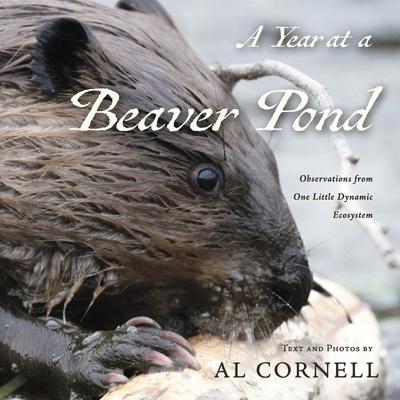
Book
A Year at a Beaver Pond: Observations from One Little Dynamic Ecosystem
by Al Cornell
(Write a Review)
Hardcover
$49.00
Though small, that mini ecosystem adds dramatically to the adjacent habitat. In the sediment beneath the pond, a myriad of insect larvae feed on deposited organic matter. Most of them, at some stage in their metamorphosis, become food for fish, birds, raccoons, or larger insects. In turn, fish become food for larger fish, birds, and mammals. This book is the product of observing insects, toads, and trout along with 61 species of birds and nine species of mammals that were drawn to the footprint of the pond. By the footprint, I mean the pond, the dam, and the vegetation growing at the immediate edge of the pond.
Otter were elusive until one finally decided to frolic in the magical early morning light. A beaver even used a rock for a dam repair. Warblers, swallows, flycatchers, and waxwings fed on insects from tiny moth flies to long-legged craneflies. The trout feeding activity peaked when dozens were jumping during the midge hatch. A raccoon brought her young ones to sift through the sediments for edible morsels. Sandpipers and snipe probed the shallow water and the mudflats for earthworms and larvae. When mudflats were exposed, mink, a cottontail, and many birds used them for travel and feeding. The little remnant willow near the blind was searched by small birds, used as a landing spot by those feeding on flighted insects, and used by kingfishers and herons that fed on trout. Jewelweed, blooming on the dam, enticed hummingbirds and bumblebees.
The ecological wonder of beaver ponds helps establish a sense of the value of beavers. By gradually overcoming the bias that they are just a nuisance, perhaps at some point, we will be able to tolerate half of the population that inhabited this continent before the massive fur harvest decimated them.
Though small, that mini ecosystem adds dramatically to the adjacent habitat. In the sediment beneath the pond, a myriad of insect larvae feed on deposited organic matter. Most of them, at some stage in their metamorphosis, become food for fish, birds, raccoons, or larger insects. In turn, fish become food for larger fish, birds, and mammals. This book is the product of observing insects, toads, and trout along with 61 species of birds and nine species of mammals that were drawn to the footprint of the pond. By the footprint, I mean the pond, the dam, and the vegetation growing at the immediate edge of the pond.
Otter were elusive until one finally decided to frolic in the magical early morning light. A beaver even used a rock for a dam repair. Warblers, swallows, flycatchers, and waxwings fed on insects from tiny moth flies to long-legged craneflies. The trout feeding activity peaked when dozens were jumping during the midge hatch. A raccoon brought her young ones to sift through the sediments for edible morsels. Sandpipers and snipe probed the shallow water and the mudflats for earthworms and larvae. When mudflats were exposed, mink, a cottontail, and many birds used them for travel and feeding. The little remnant willow near the blind was searched by small birds, used as a landing spot by those feeding on flighted insects, and used by kingfishers and herons that fed on trout. Jewelweed, blooming on the dam, enticed hummingbirds and bumblebees.
The ecological wonder of beaver ponds helps establish a sense of the value of beavers. By gradually overcoming the bias that they are just a nuisance, perhaps at some point, we will be able to tolerate half of the population that inhabited this continent before the massive fur harvest decimated them.
Hardcover
$49.00